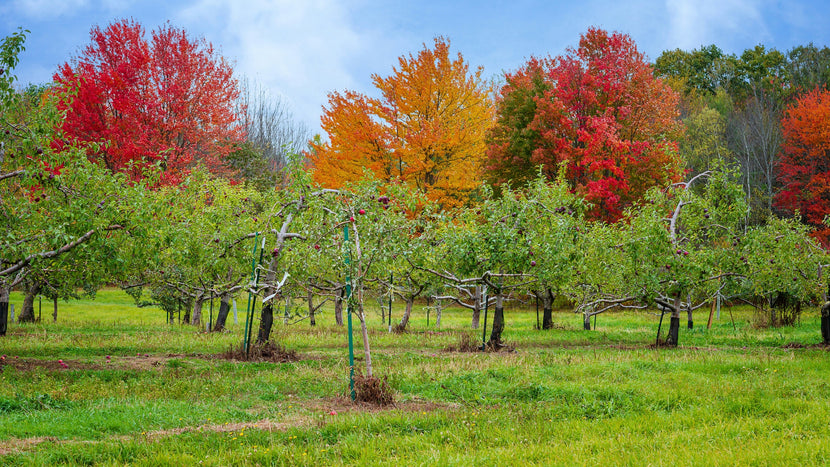
Woodie’s Picks: Four Fruiting Favorites For a Bountiful Harvest
Did you know that fall is the best time to plant trees? Specifically, fall is a great time to get your fruit trees in the ground! The conditions of fall are optimal for the acclimation of your trees as the season provides a perfect balance of warm and cool weather.
Beyond the perfect conditions, fall is a great time to plant your fruit trees because they are headed into dormancy. As they change color and lose their leaves, their energy transitions from fruit and foliage production to just focusing on protecting and strengthening their root systems. This cycle leaves you with the best foundation possible for a happy and healthy tree with beautiful spring blooms and a bountiful harvest next fall!
Because conditions are ideal for planting, this week's Woodie's Picks will feature four of our fruiting favorites, which never fail to add beauty, interest, and fun to a landscape!
Favorite Fruit Trees To Plant In Fall
Pawpaw Tree

First on our list of fruiting favorites is an underdog and a much lesser-known fruit tree: the pawpaw tree. However, we don’t expect this tree to stay in the dark for long!
As seen recently featured in The Washington Post, the pawpaw tree is highlighted as a resilient native variety that can better withstand the environmental hurdles that come with climate change! The article highlights, “As climate change brings warmer temperatures and more erratic weather to the region, a small but growing number of farmers are drawn to pawpaws’ low maintenance and adaptability.”
The unique trees produce greenish-black fruits that range in size from three to six inches long. Nicknamed “the poor man’s banana,” pawpaws are often described as a combination of mango, banana, and pineapple. The fruits typically ripen in September and are popular for a range of uses, including puddings, preserves, butters, and jams!
Additional benefits of the Pawpaw tree include an impressive drought tolerance and its attractiveness to local pollinators! For landscaping purposes, people are drawn to the Pawpaw for its ornamental features and its ability to provide shade in the summertime heat! Consider planting this tree as a focal point in the landscape, or plant in mass for a fruit-filled life of luxury!
Elberta Peach Tree

Next on the list of fruit trees our customers (and we) can’t get enough of is the sweet and show-stopping Elberta Peach Tree. The mass of hot pink blooms this tree produces is enough to make you swoon! But then, you have a harvest of sweet juicy peaches to look forward to as well! Not to mention, the Elberta Peach Tree produces a gorgeous show of fall color before heading into dormancy.
Our customers frequently rave about the Elberta Peach Tree for its self-fertile nature. This ensures that you do not need another tree to fertilize your plant in order to produce fruits. You can, however, increase fruit production by planting them in pairs! The popular fruiting tree produces classic yellow peaches ready for harvest in September.
The Elberta Peach Tree is also praised for its impressive cold hardiness! The tree is said to tolerate temperatures as low as -10 degrees making them suitable for a wide range of climates. Ideal conditions for this tree include full sun and a slow-release fertilizer for best results.
Honeycrisp Apple Tree

We simply could not list our favorite fruiting trees without incorporating this classic: the Honeycrisp Apple Tree! With its disease resistance, cold hardiness, and quick growth rate, there is so much to love about this incredible specimen!
Don’t even get us started on the fruits! Honeycrisp Apples are sweet and juicy, leaving you with a honey-sweet flavor with subtle hints of pear. Great for baking or just as a stand-alone staple snack, the Honeycrisp never ceases to satisfy!
In addition to its incredible flavor, the Honeycrisp Apple Tree busts an impressively long harvest season and continues producing apples often for weeks longer than other varieties! As an added benefit, Honeycrisp Apple Trees have a reserved root system, so they can be planted close to your home without fear of structural damage!
Persimmon Tree

Another lesser-known but still well-loved fruit tree is the American Persimmon Tree! Hardy to zones 5-9, these trees are incredibly low-maintenance and do not require intricate pruning and frequent spraying that some other fruit varieties call for.
Native to southern and eastern regions of the US, the American Persimmon is said to be fairly adaptable to a wide range of conditions. The species is particularly known to tolerate poor soils that are low in nutrients, rocky, sandy, or poor draining where much else fails to thrive!
Now onto the juicy stuff–the flavor! American Persimmons have a rich, sweet, and complex flavor that is said to carry notes of caramel, tangerine, and custard. These fruits are best eaten when they are fully ripe and soft to the touch. The fruits are typically ready for harvest in early to mid-November.
As for the value they bring to a landscape…Persimmon trees add color to your property in numerous ways with their fragrant white blooms in spring, vibrant orange fruits in the fall, and dark, rough trunks that stand out in the winter! It is important to note that the American Persimmon tree is not typically self-pollinating, so you will want to get a second tree to get a good harvest of fruits!
Shop Fruit Trees Online Today
Planting fruit trees adds beauty, interest, and value to both your property and your life! Nothing beats being able to enjoy the fruits of your labor (literally!). No matter what fruit fancies your taste, here at Garden Goods Direct, we pride ourselves in having a wide variety of fruit trees available for shipment directly to your doorstep!
